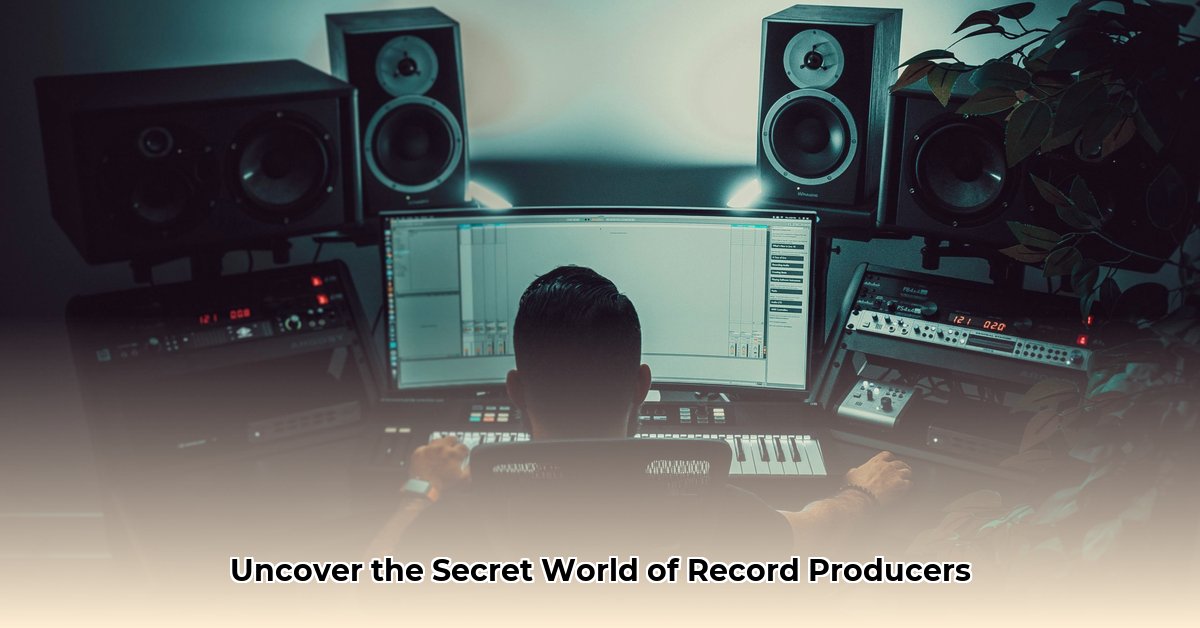“`markdown
What is a Record Producer: A Complete Guide to Roles and Skills
Want to know what a record producer actually does? It’s more than just pushing buttons. Think of them as the architects of a song, the ones who take an artist’s raw talent and mold it into something amazing. They’re involved from the initial concept to the final mix. We’ll break down exactly what that entails – from working with artists to choosing the right songs and studio, to ensuring the final product sounds phenomenal. We’ll even include tips for aspiring producers, sharing insights from the legends and offering advice to help you navigate this exciting and sometimes challenging industry.
Understanding the Record Producer’s Role
What exactly is a record producer? More than someone who fiddles with knobs in a studio; they are the song’s architect, the director of the musical movie, the ultimate shaper of sound. They’re the glue that holds everything together, guiding artists to reach their full creative potential and ensuring the music resonates. Let’s explore the fascinating world of record production!
Pre-Production: Laying the Foundation
Before any music is recorded, the producer is hard at work. This phase is like building the foundation of a house—critical for success. It involves artist collaboration, song selection, creative concept development, and meticulous budgeting. It ensures everyone is aligned before tracking begins.
Imagine collaborating with a rising star like Olivia Rodrigo. A producer would work closely with her, perhaps helping choose songs that highlight her emotive vocals and relatable lyrics. Together, they’d define the overall sound—a blend of pop-punk energy, confessional singer-songwriter intimacy, and maybe a touch of alternative rock grit—setting the vibe for the entire album. This collaborative process is key; the producer guides and supports the artist’s vision. Meticulous budgeting in pre-production can save upwards of 20% of overall project costs by anticipating needs and avoiding costly overruns.
Recording: Capturing the Magic
This is where the real magic happens! The producer carefully selects a recording studio that fits the project’s needs and sound. Then comes tracking—recording instruments and vocals. The producer is constantly involved, offering guidance and feedback to the musicians. They might suggest different arrangements, experiment with unique sounds, or provide encouragement. Think of how legendary producer Quincy Jones shaped Michael Jackson’s sound.
During vocal takes, producers consider mic placement, proximity effect, and the vocalist’s comfort to capture their best performance. They also determine optimal signal chains for each instrument, using preamps, compressors, and equalizers to sculpt the sound during the recording process. Their expertise in recording techniques, from drum tuning to amplifier selection, is vital for achieving the best possible sound. This stage is a balance between creative vision and technical precision. They might even bring in session musicians to add extra polish or experiment with unconventional instruments to broaden the sonic palette.
Post-Production: Polishing the Diamond
Post-production transforms raw recordings into a polished masterpiece. Mixing balances individual tracks—adjusting levels, equalization (EQ), compression, and effects. Think of it as a painter adjusting colors to create a harmonious image. Mastering, the final stage, ensures consistent volume and overall quality, making it ready for release.
Sound design is another critical aspect. Producers are skilled at manipulating sounds, using digital audio workstations (DAWs) and plugins to create unique textures and sonic landscapes. They might add layers of sound, create custom effects, or use innovative techniques to give the music a specific feeling or vibe. The producer is a craftsman and an artist, carefully sculpting the sonic environment to make the final product compelling and engaging. They might experiment with granular synthesis, convolution reverb, or other advanced techniques to create otherworldly soundscapes. Also, producers must provide creative ideas on how to handle stems, which are the individual tracks from a finalized song that can be sold or used to make soundalikes.
The Business Side
While the creative side is vital, the business aspects are important for a producer’s success. Producers often negotiate contracts with record labels, oversee marketing campaigns, and participate in promotional efforts. While not their primary focus, understanding the business side is crucial for getting the music heard and the artists paid.
Producers need to understand royalty splits, publishing rights, and licensing agreements. They may also be involved in securing funding for projects, managing budgets, and tracking expenses. Furthermore, producers often act as liaisons between the artist and the label, advocating for the artist’s vision and ensuring their best interests are represented. Building a strong network of industry contacts—lawyers, managers, publicists—is crucial for navigating the complex business landscape.
Essential Skills of a Record Producer
| Skill Category | Specific Skills | Importance Level |
|---|---|---|
| Technical Skills | DAW expertise (Pro Tools, Logic Pro, Ableton Live, FL Studio), audio engineering, mixing, mastering, sound design, MIDI programming, sampling | High |
| Creative Vision | Musicality, arranging skills, understanding various music genres, artistic direction, songwriting skills | High |
| Interpersonal Skills | Communication, teamwork, leadership, conflict resolution, empathy, diplomacy | High |
| Business Acumen | Contract negotiation, budgeting, marketing, promotion, financial management, networking | Medium |
Frequently Asked Questions (FAQ)
Q: Do I need formal training?
A: Formal training can be helpful, but it’s not strictly necessary. Many successful producers are self-taught, demonstrating that passion, dedication, and practice can go a long way. Look for courses that focus on specific skills such as mixing, mastering, or sound design.
Q: What software do I need?
A: There are options for every budget and skill level. User-friendly DAWs like GarageBand (free) and Ableton Live Lite are great starting points. Pro Tools, Logic Pro, and FL Studio are industry standards but require more time and effort to learn.
Q: How can I find work?
A: Networking is key. Build relationships with other musicians, engineers, and artists. Create an online portfolio showcasing your work. Reach out to independent artists and offer your services to gain experience. Consistent effort is essential. Internships at recording studios or production companies can also be valuable.
Becoming a successful record producer requires a blend of technical skills, creative flair, and strong interpersonal abilities. It’s a collaborative role that demands dedication to both the artistic and technical sides of music creation. Great producers don’t just make music sound good; they shape musical trends and leave a lasting impact on the industry.
How to Quantify a Music Producer’s Creative Contribution Across Genres
Performance metrics (streams, likes, shares) impact music creation and vary by genre and platform. Quantifying a producer’s creative contribution is challenging but crucial in a data-driven industry. Producers guide artists through the complexities of metrics while maintaining artistic integrity and balance artistic vision with data-informed strategies for release and promotion. Longitudinal studies are needed to understand the long-term effects of metrics on artistic creation.
Pre-Production: Laying the Foundation for Measurable Impact
Pre-production is where the producer collaborates with the artist, shaping the song’s core concept, selecting tracks, and establishing a budget. Quantifying this is challenging. You can’t assign a numerical value to a brilliant lyrical idea, but you can measure the impact on the final product by comparing initial demos to the final recorded versions, analyzing changes in structure, arrangement, and lyrical content.
This allows for a before-and-after analysis that showcases their creative steering. The more significant these changes and the more positive their effect on the final product, the greater the producer’s impact. Did they help hone a raw idea into a polished track ready for recording? That’s quantifiable. For example, if the producer suggested a key change that made the chorus more impactful, and the song’s streaming numbers jumped significantly after release, that’s a quantifiable metric of their contribution.
Recording: Capturing Sound with Quantifiable Choices
The recording phase involves selecting the right studio and guiding performances, refining arrangements, and making crucial decisions about instrumentation and vocal mixes. How do you quantify a music producer’s creative contribution across genres in this chaotic atmosphere? One approach is to identify key production choices that shaped the final sound signature of the finished product. Consider this: did their choices in microphone placement and effects significantly impact the song’s dynamic range and overall emotional impact? Were those intentional creative decisions that elevated the overall sound?
These elements contribute to the quantifiable success of this stage. For example, did the producer’s specific choices of microphone and preamps for the lead vocal result in a warmer, more intimate sound that resonated with listeners, as evidenced by positive reviews and increased listener engagement? Comparing the sonic characteristics of the raw recordings to the final mixed versions can also reveal the extent of the producer’s impact. Were there unconventional effects or processing techniques used that gave the song a unique sonic signature? These are all factors that can be analyzed and quantified to assess the producer’s creative contribution.
Post-Production: Polishing the Gem with Measurable Refinements
Post-production is the fine-tuning phase. Mixing balances the sounds; it’s like a painter adjusting colors. Mastering adds the finishing touches to make it listenable on any system. Sound design can significantly affect the atmosphere. How should this be quantified? Consider comparing a poorly mixed track to a professionally mixed one.
If the producer significantly enhanced the clarity, punch, and overall sonic impact of the recordings, leading to a more engaging and commercially viable product, that can be quantified. If the producer brought in a sound engineer
















